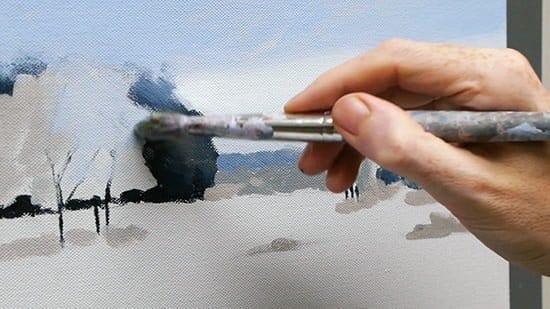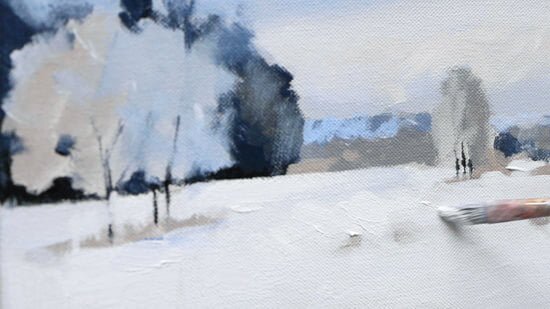
Snow.
It can seem a tricky subject to capture.
Is it white? Is it blue? How do you paint it to look soft, or darken it without it looking dull?
Having a ‘less is more’ approach to your palette can reflect the colours of Winter absolutely perfectly – without getting complicated.
And the first clue to a convincing Winter snowscape, is the sky…
Observing the light quality of the sky
Successful landscape painting in any season requires observation of the light.
Is it strong and bright or soft and diffused?
Different light will alter the colour saturation, shadows and mood of a scene, so assessing the lighting qualities of the sky is important to guide your choice of pigments and brushstrokes.
So what are you looking for in your subject?
- What Season is it?
- How high or low is the sun in the sky?
- What time of day is it?
- Is there cloud cover or a clear blue sky?
- Is there fog or mist creating a haze?
A step-by-step Winter Landscape Painting in Acrylic
Video Tutorial – Part 1
Video Tutorial – Part 2
Winter Morning
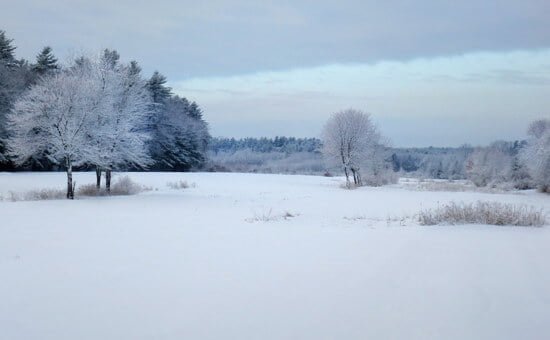
Photo Credit: “Winter Morning” by Liz West Licensed under CC BY 2.0.
In our Winter scene above, the main light coming from the sky is diffused behind thick clouds with a low-level glow of the sun peaking through, giving us a compressed tonal range, muted colours and shadows on the ground or in the snow that are soft, with diffused blended edges.
The softer the light source, the softer the edges, these are all key elements that make a Winter scene appear magical.
- Dull and soft light – muted colours, narrow or compressed tonal range, less contrast.
- Bright and hard light – saturated colours, wider tonal range, more contrast usually Summer which has a wide tonal range with high saturation.
Tonal value & range in a winter scene
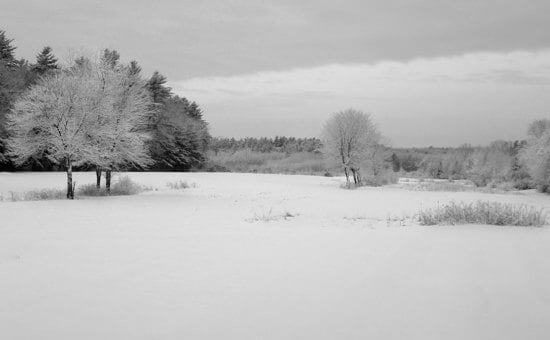
When I’m painting landscapes, I’m essentially looking for ranges of light and dark and assessing the values in the scene by eye.
The easiest way to see this when you’re first starting is to turn your image into black and white.
This creates what can be called a ‘tonal map’, ‘value map’ or ‘tonal range’ but the main thing to remember is how wide or compressed that range is, as it will influence how light or how dark you can go with your pigments.

Tones of black and white appear on a ‘tonal value scale’ that goes from light to dark

In our reference image above, you can see how close in value the sky is to the value of the snow.
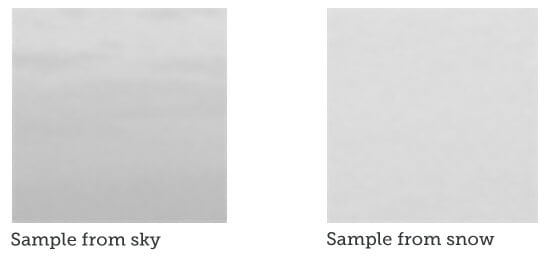 It can be misleading to our perceptions because when you think of snow, you usually think of white and apart from the very darkest areas on the left of the image, the majority of the tones are within 2 -3 value steps.
It can be misleading to our perceptions because when you think of snow, you usually think of white and apart from the very darkest areas on the left of the image, the majority of the tones are within 2 -3 value steps.
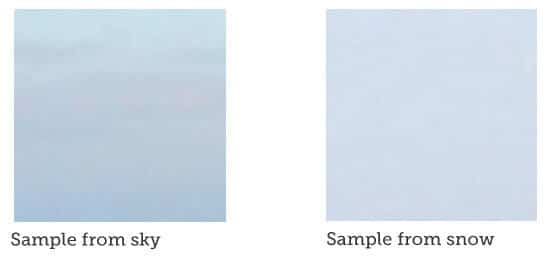 So we have a compressed value range in the least saturated season.
So we have a compressed value range in the least saturated season.
I’ll be using a very limited palette to produce beautiful pastel colours and mixing colour strings for subtle shifts in tone for the painting.
Using a limited palette & colour strings
So for this study, we’ll begin with a warm and cool palette from the blue and orange family, alongside pre-mixed grey neutrals.
I wanted to keep this tutorial simple and impressionistic, working within the discipline of Burnt umber and Ultramarine blue to capture the essence of the scene.
If you get into the practice of pre-mixing colour (or tonal) strings and then only use those colours, it will give you a much more compelling picture. Now you have to realise that this will all come together when the picture is complete – the urge to add darker or lighter paint to the compressed range or brighter saturated new colours to the mix will be hard to resist!
Downloading the reference photograph
The photo below can be ‘right clicked’ and ‘Save image as’, so you can use it as a reference image, print it out and follow along with the video above.

Photo Credit: “Winter Morning” by Liz West Licensed under CC BY 2.0. Please Note: The Original photograph has been cropped down to the Golden Ratio proportion used in the painting.
You can also download a High-Resolution Image here...
Materials you will need:
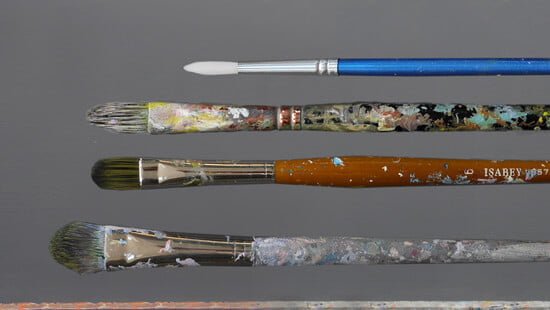
Brushes
- 2-inch Purdy decorators brush – XL Monarch Elite
- Small nylon round brush – This brush didn’t have a brand name or specific size on the brush, any small round will be fine. The dimensions are approx 3-5mm in diameter and 1.5 – 2cm in length
- Jacksons Art Black Hog Bristle Brush, Size 4 – Series 335
- Isabey Isacryl Acrylic Brush, Filbert shape, Size 6 – Series 6572
- Isabey Isacryl Acrylic Brush, Filbert shape, Size 10 – Series 6572
Palette knife
- RGM Classic Line, Medium size 45, Diamond shaped, cranked (angled) handle. I use an RGM 45 for mixing the paint on the painting and a larger sized square palette knife (RGM 81) for mixing the coloured ground. You don’t need the RGM 81 but the larger the palette knife the quicker you can mix larger amounts of colours.
Support
- Jacksons Art (UK) 10 oz cotton duck canvas 20 x 32.4cm (Code: CJS2032) that has 2 coats of white acrylic gesso applied.
I demonstrate on a 10 oz cotton duck canvas, 19mm Profile and the ratio I use for the main paintings are based on the Golden ratio
An alternative brand in the US is Masterpiece Fibonacci Golden Rectangle Canvas
Other materials
- Kitchen roll/paper towel
- Clean water
- Tear-off palette or stay-wet palette (I demonstrate on an A3 size tear-off palette)
Paints – The colour palette
Artist quality acrylic colours. I’ve used a mix of Golden Heavy Body colours & Winsor & Newton Professional Acrylic (also called Artist Acrylic)
The first colours are a selection of Neutral Grey (Gray) tones.
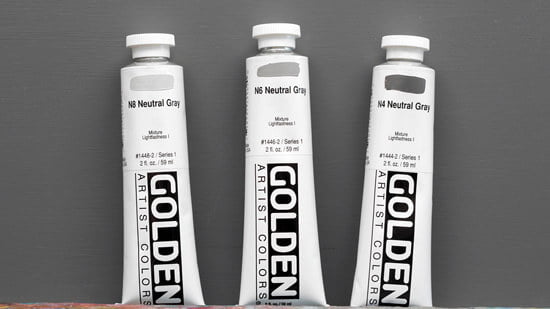
- Neutral Gray N8
- Neutral Gray N6
- Neutral Gray N4
Pro tip: If you don’t have access to these neutrals you can mix your own neutral with a Burnt umber, Ultramarine blue and Titanium white.
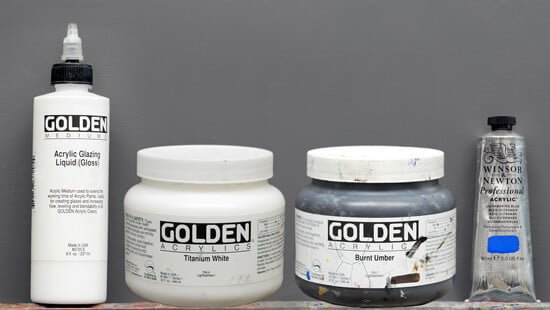
- Titanium white
- Ultramarine blue
- Burnt Umber
Mediums
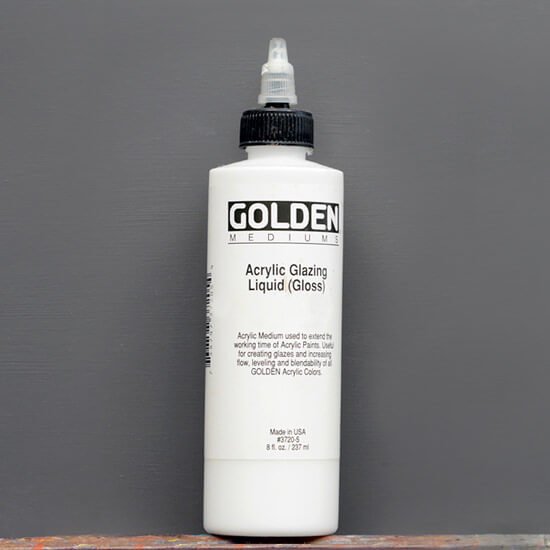
Acrylic Glazing Liquid ( Gloss) Golden Paints. This will extend the working time of the paint and enable thin applications of the paint with smooth smokey blending. What I like about Glazing Liquid Gloss as a medium, is you can use it in any ratio in with your paint and it still brushes well and remains a nice paint film integrity.
Step 1. – Choosing a coloured ground
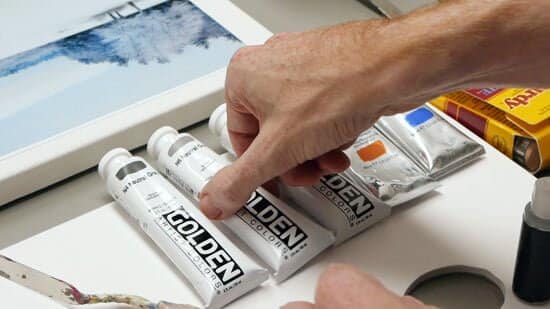
For the ground colour, I wanted to knock back the white of the canvas but not add too much variety in colour so I went for the Neutral 8 Gray.
Step 2. – Mix a fluid consistency
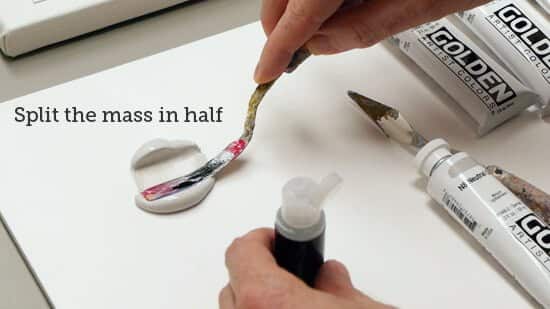
To prepare the paint consistency for the ground colour, squeeze out some of the paint and then split the mass of the paint in half.
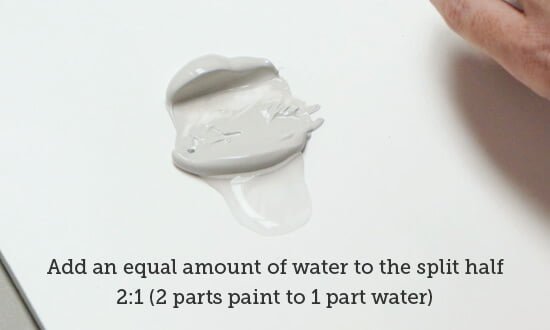
Then add equal amounts of water to 1 part of the split half.
So you will have 2 parts paints: 1 part water, diluting the paint by 50%.
Pro tip: You can dilute heavy body paints with water and still remain good paint film integrity. This is from Sarah Sands, Technical Services Supervisor for Golden Artist Color.
“Heavy Body acrylics can easily be thinned up to one part paint to one part water, or a 1:1 ratio, and maintain excellent adhesion onto absorbent surfaces. In fact, even when testing this on a non-absorbent material like Plexiglas, the paints still formed good films with no adhesion failures after being allowed to fully cure.
To add even a little more comfort beyond that, we can share that the adhesion onto Plexiglas remained solid even when thinning with one part paint to two parts water, or a 1:2 ratio. Which would feel like a fairly fluid wash for most people.”
You can read more about preparing a support and dilution levels here
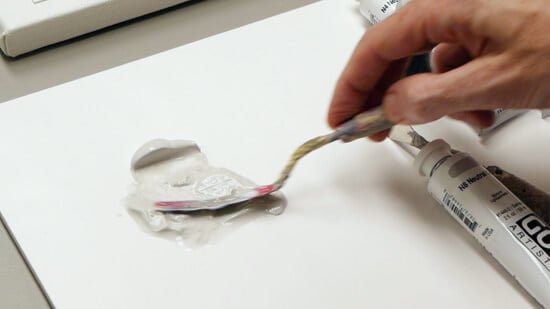
Then mix the first half together well with the water.
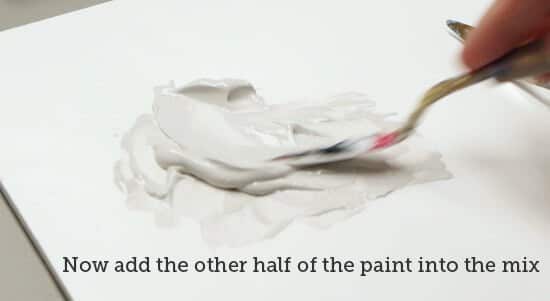
Once the water has been incorporated into a smooth mix, combine the rest of the paint so you have a fluid mix.
Step 3. – Paint the coloured ground
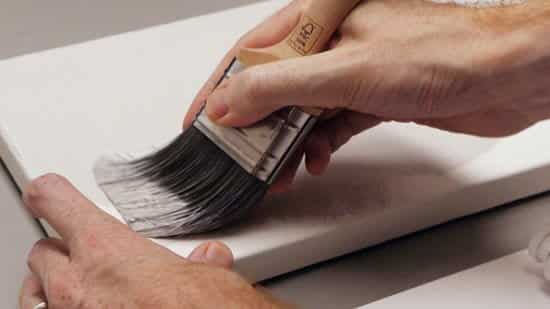
Using a 2-inch decorators brush, push the paint into the canvas weave.
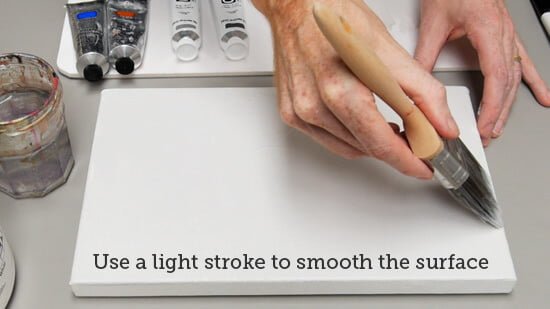
Then use light strokes over the surface to create a smooth, even tone.
Step 4. – Drawing Out
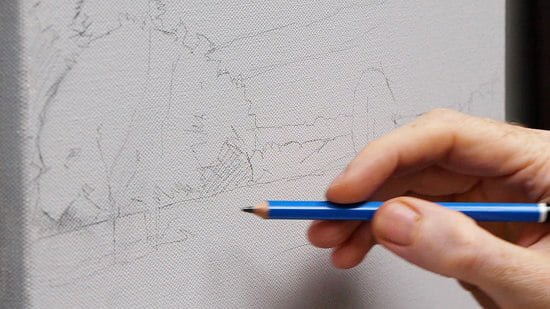
I draw out the basic shapes of the composition using a 3B pencil (Staedler Mars Lumograph). The main shapes I’m looking for are the circular shapes of the trees on the left and then the shape of the tree in the middle that breaks through the horizontal.
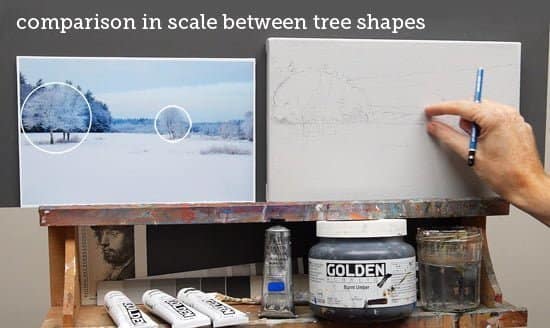
The middle tree shape is about half the size of the main tree on the left.
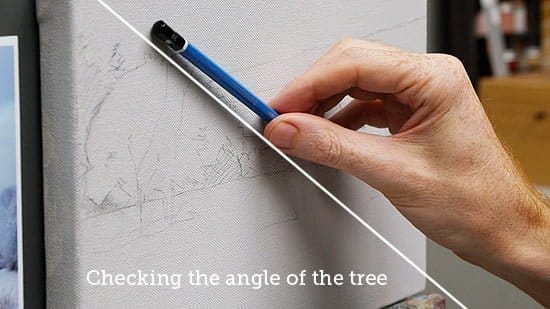
Then check the angle of the tree that brings your eye into the centre of the picture as this will help to guide the viewers eye into the far distance. I’ve also indicated where the dark areas of the painting will be by hatching with the pencil.
Step 5. – Setting out the paints
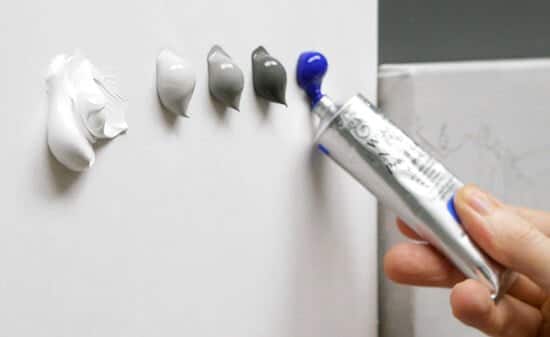
I set out the paints in a tonal range from white, lightest grey, middle, grey, dark grey through to the darkest tone.
Step 6. – Painting in the darkest tones

I mix a dark blue/black from the Burnt Umber and Ultramarine Blue. Using the small nylon round brush I paint in the darkest areas of the painting. You can vary the intensity slightly by adding a touch of water to the mix.
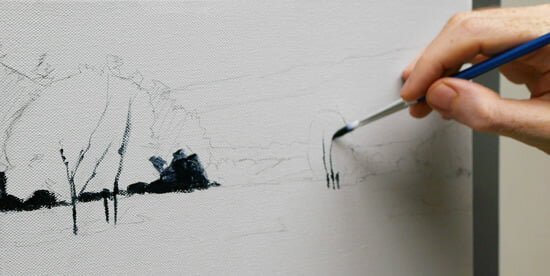
When painting in the darks of the tree trunks, start from the bottom and then taper up your brushstroke from the bottom up. As the brush strokes reach the top lift off the pressure to create a feathered edge.
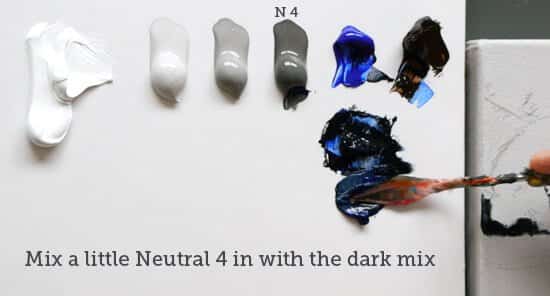
Then mix in a little Neutral 4 with the first dark mix so it slightly lifts the tonal value. Don’t add too much of the N4 at this stage.
Step 7. – Blocking in tones with a filbert brush
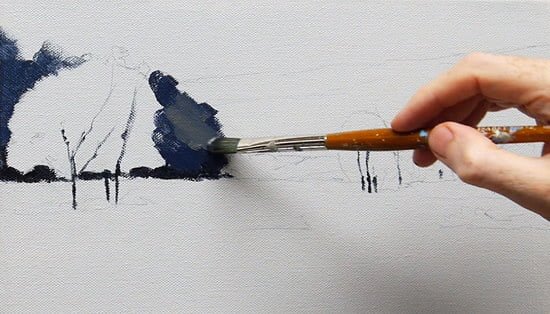
I now swap to the Size 6 Filbert Isabey Isacryl brush and paint on a slightly lighter blue mix on top of the dark tree shape, I’m working in wider blocks of colour with gestural marks.
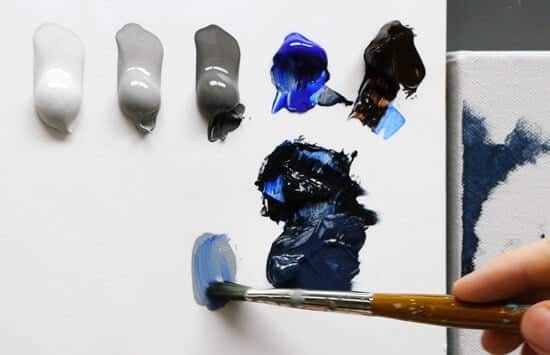
Now grab a little of the Neutral 6 (N6) and add a touch of the pure Ultramarine blue.

Paint this mix onto the far horizon line, I then alter the darkness of the mix to paint in variations of darker shapes on the far right side. You can already start to see the shapes of the trees emerging and the balance between the cool blue and the neutral grey ground colour.
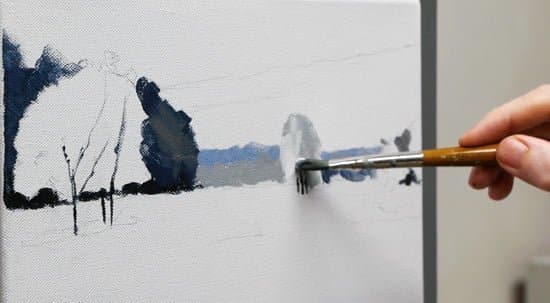
Working with the N6 & N8 I paint in the central tree, still working with the size 6 filbert brush.
Step 8. – Adding warmth with Burnt Umber

We can now introduce some warmer colours to the composition by mixing some Burnt umber with Neutral 6.
I paint this on the left-hand side of the tree and then use the same colour to paint the shadow tone under the tree
Step 9. – Mix muted blues for the sky
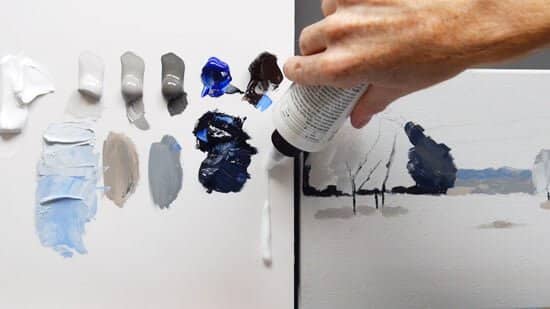
In preparation for the sky, I mix a colour string of two muted light blue colours. The colour is a mix of Titanium white, Neutral 6 and Ultramarine blue. I also add some Acrylic Glazing Liquid (gloss) to the palette.
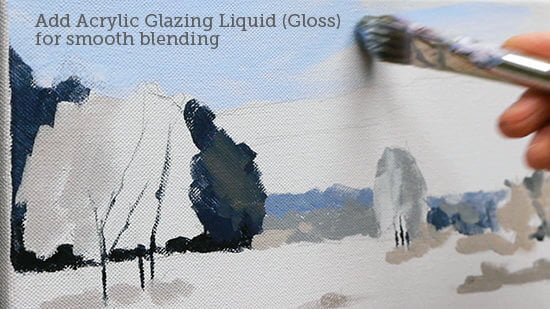
Swapping to the larger size 10 Isabey Isacryl filbert, I paint on the darkest of the two blue mixes to the top of the painting. The application is quite thin as I want some of the Neutral ground colour to show through to ‘warm’ the sky from behind.

Then paint on the lighter blue mix to the bottom half of the sky. When the top and bottom of the sky are still wet add a touch of Acrylic Glazing Liquid to the end of the brush and gently work over the join between the two colours so they softly blend together.
Still using the size 10 filbert, I paint a few more gestural strokes onto the tree edge. Loosening up your landscape paintings with gesture to capture the rhythm of the subject, bold brushwork and having a broken edge can give an illusion of branches from a distance, so keep it scratchy.
Step 10. – Mix muted white for the snow
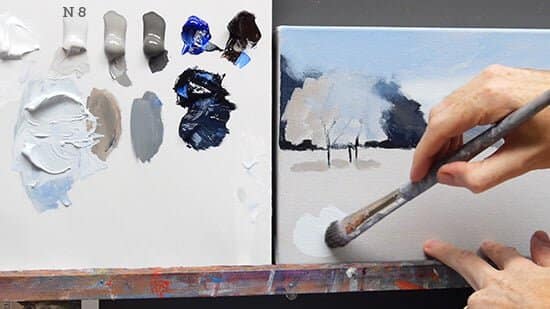
I now mix another colour string with the Titanium white, N8 and a tiny amount of Ultramarine blue. Then apply the darker of the ‘white mixes’ to the bottom of the canvas.
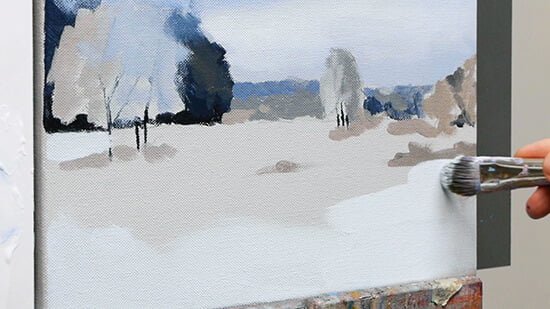
Paint the darker tone in a semi-circle at the bottom of the canvas.
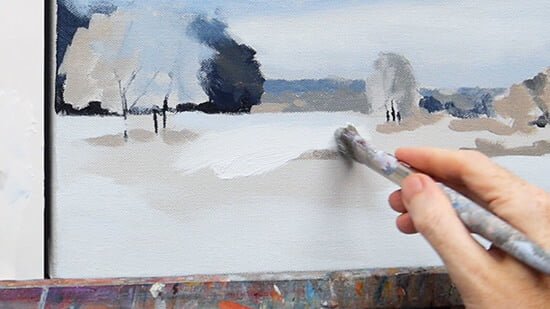
Then add the lighter mix to the rest of the canvas working quite quickly with the brushstrokes.

Step 11. – Add texture with a bristle brush
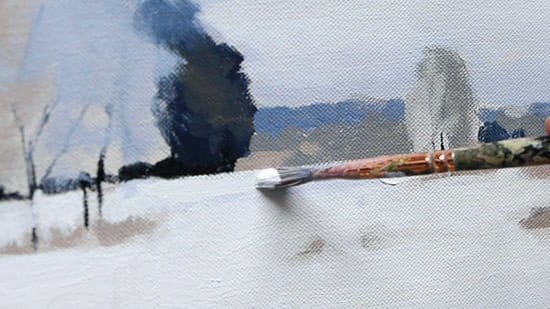
I now swap to the size 4 Black hog hair brush. This is a stiffer bristle brush and will give more visible brushmarks and texture.
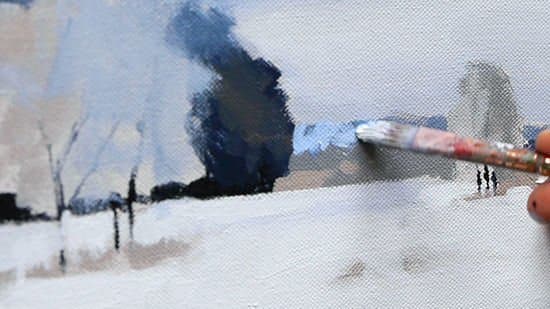
I then mix a cleaner, brighter blue for the mountains in the far distance.
Step 12. – Add a subtle warm white to the sky

With a little Burnt umber and white I can warm up and lighter the area where the sun is illuminating the clouds.
Step 13. – Refine the shapes and darks
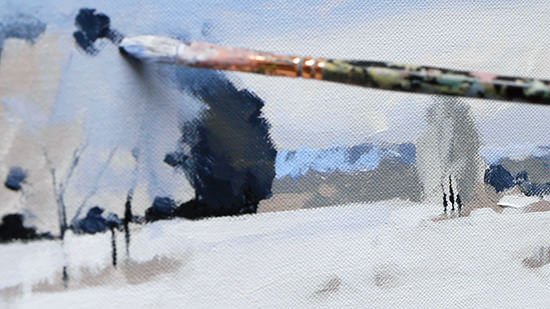
Working around the edge of the tree on the left I tweak the shapes so they have a nice balanced pattern.
Step 14. – Add thicker white to the center
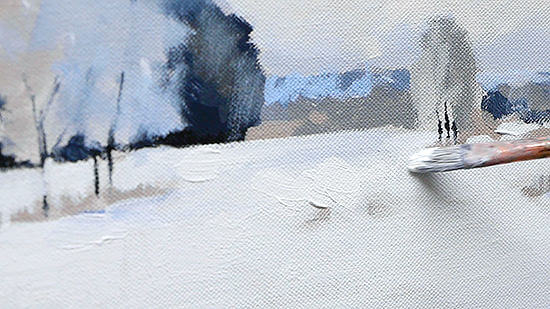
Still using the bristle brush, build up a thicker impasto area of white in the centre of the painting to subtlety guide the viewers eye into the middle of the picture and maintain a loose, painterly quality.
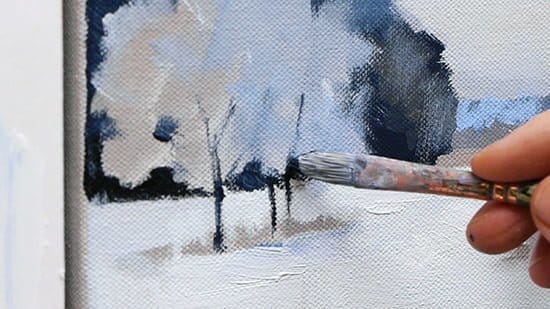
I then reinforce the dark tree trunks using the side edge of the bristle brush.
The final painting
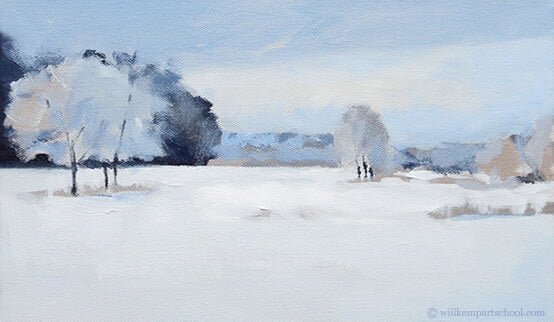
You can watch the full video tutorial (30min) below. Enjoy!
Video Tutorial – Part 1
Video Tutorial – Part 2


